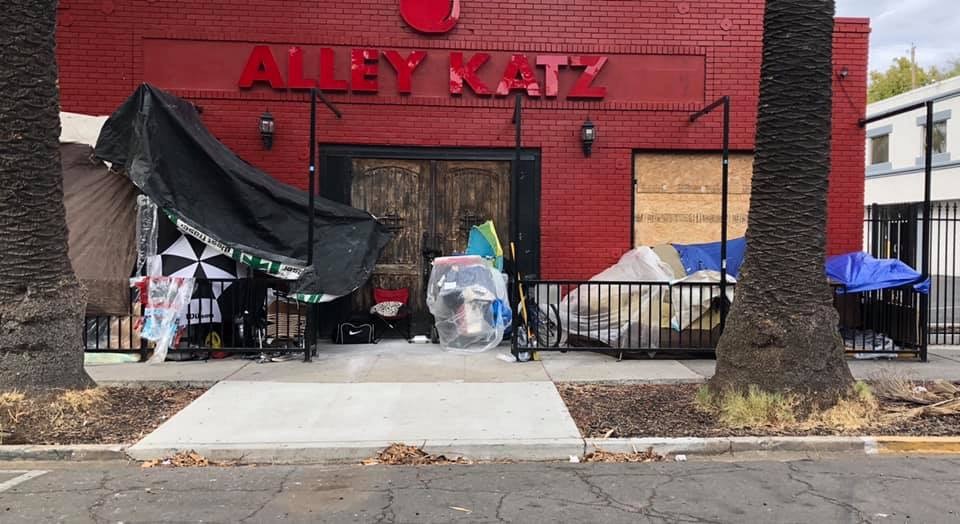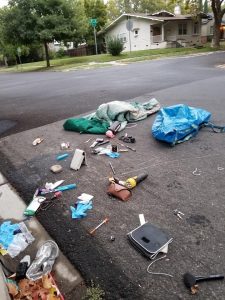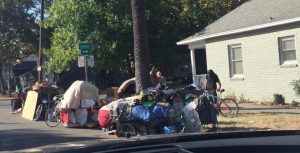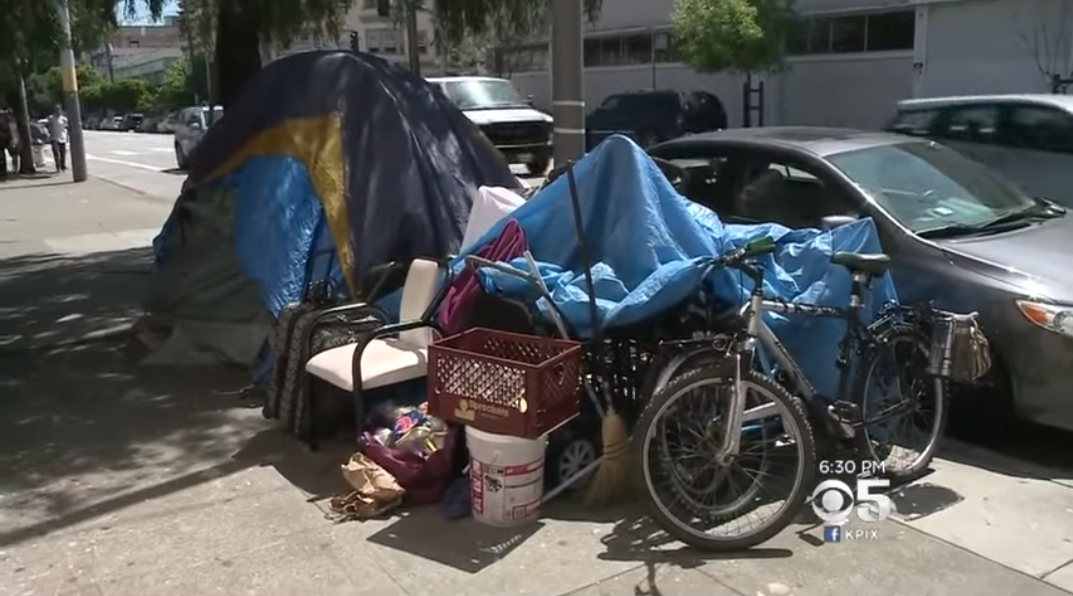
Homeless vagrants in Sacramento
First Hand Testimony: How the Homeless Crisis is Changing the Safest Communities in California
Residents and tourists say the drug-addicted transients are ruining Sacramento
By Ramona Russell, October 4, 2019 6:58 am
‘We need our neighborhood back. We need public safety reforms and more police presence in our community, and higher numbers of law enforcement overall.’
In our last article we featured the issues affecting the historic Sacramento neighborhood of Land Park, which has been considered the safest community in Sacramento for decades. But residents and business owners say that is no longer the case, citing the transient population as the cause for rampant drug activity, serial theft and violence.
Jennifer Mann, who lives in Land Park and works in downtown Sacramento in the hospitality industry, says she hears from her clients about cities they will no longer take their business to for fear of their attendees’ safety. “There are comments that Sacramento is looking like one of those cities, which is sad, as we have really moved in an exciting direction with development and energy in the downtown core. But even more disturbing to me, and what impacts my daily life and the lives of my children, are the transients that in recent years have been pushed out of downtown to live under the freeways, and into these beautiful, historic neighborhoods. It saddens me that I no longer feel safe to let my children walk to school or go to the park. I have neighbors who have found needles near the play structures, have found people sleeping or sneaking into their backyards, and a few that have had dangerous interactions with these individuals.”

Jocelyn Munroe, an 18-year resident of Land Park who has volunteered at Loaves and Fishes, is a business owner and has written and published books on the history of Sacramento. “About a year ago, my niece came out to visit from the East Coast to see my business and potentially work for me. She was extremely shocked at the level of vagrancy and the number of transients in Northern California. We went to San Francisco where we walked by alleys filled with tents and kicked aside numerous orange caps from syringes on the sidewalks. In Sacramento, we passed by a trash-strewn tent village on the side of Freeport Boulevard and when we biked to Old Sacramento along the river, we had to weave through bike chop shops and drug addicts passed out on the sidewalk and park benches. It was hard explaining to her why this existed; she couldn’t wait to leave.”
A transient passed out in front of Munroe’s home. She has installed security cameras due to the amount of package theft her neighbors are experiencing. “I’m worried about my property value and personal safety. I’m worried about the public health issues in our waterways. I’m concerned about the people on the streets and their quality of life, and wonder where my always-increasing property taxes, city taxes and sales taxes are going. The situation is getting worse not better. I love Sacramento; this is my home. I know that this is a complicated problem, but there must be some accountability somewhere. We have too much bureaucracy.”
Julie Shulman, a social worker who knows firsthand the difficulties involved with assisting individuals who are addicted to drugs and/or living with mental illness, believes the health and safety risks that our community is experiencing is a travesty. She has lived in Land Park for forty-five years and says the neighborhood bears little resemblance to the one she grew up in. “I can’t walk around my neighborhood anymore without seeing people that are either addicted to narcotics, have a severe mental illness, or both. They sleep off their drug-induced highs on our front lawns and porches, use our bushes as their public restrooms, and yell obscenities if we try to ask if they need help or assistance.”
“This city is failing at taking into consideration the quality of life and public safety of hard-working, tax-paying residents,” Shulman says. “Why can’t I feel safe walking to Midtown? Why is almost every freeway underpass littered with tents, stolen bicycles, trash, human waste, and hypodermic needles? This is not acceptable.”
J.R. Riddell, who has been heavily involved in his community, says he never expected that he would consider moving away to a safer neighborhood. He has witnessed people passed out with needles in their arms in front of businesses and using the sidewalks, buildings, and alleyways as bathrooms. He has had a transient jump over his fence from another back yard in broad daylight and had items stolen twice from his front porch. “Land Park and the surrounding areas have transformed in a bad way over the past several years, and it’s primarily due to the drug-addicted segment of the homeless population. These were not problems when we moved into the neighborhood sixteen years ago. In fact, they weren’t major problems just five years ago. The decline in my neighborhood has been a horrible spectacle to watch unfold as my children grow. I don’t feel safe letting them walk the dog or ride their bikes.”

Riddell says he’s read and heard a lot about pushes for more housing and temporary shelters but doesn’t believe they will have an impact on the above-described problems. “The people causing these issues are not going to move into shelters and then transition into something after that. They don’t want to be in a shelter; they want to do drugs. It’s naïve and reckless to think that anyone in Sacramento is going to solve drug-addicted ‘homelessness.’ I do not and will not support using public dollars, including tax increases, to throw at problems when there is no comprehensive plan in place to address public safety concerns as a priority. We need our neighborhood back. We need public safety reforms and more police presence in our community and higher numbers of law enforcement overall.”
Melissa Mayer and her family moved to Land Park to escape the many difficulties of living in San Francisco. “We didn’t want to raise our children in an environment where every street corner smelled like urine, where we maneuvered our stroller around transients or found needles in the bushes at the playground, but if the problems in Sacramento continue to escalate as they have in the past few years, I fear that we will once again need to relocate our family.”
“In the past—both while living in San Francisco and here—we have packed lunches and bags with socks, toiletries, rain gear and other essentials to distribute to people living on the street,” says Mayer, who is Catholic and strongly believes in compassion for all individuals. “We feel this is a positive way to encourage our boys to be compassionate towards those less fortunate.”
But the last time they did this, they questioned whether or not they should expose their children to what they were seeing. “There were people who were unresponsive, people who were yelling belligerently, people who were aggressive. There seemed to have been a shift in the homeless population we were accustomed to serving. No longer were they people who fell on hard times, but they appeared to be people who were more interested in asking for money for their drug habit than they were for a meal and a pair of clean socks.”
Mayer has become more informed on what is happening at a local and state level. “Having witnessed the negative repercussions of Proposition 47, having seen a spike in crime in my once-safe neighborhood and having to tell my children that we cannot help all of those men and women asking for money leaves me angry, confused and conflicted,” Mayer said.
Kent Quong, who has lived in Land Park for almost 60 years, never imagined that he would want to leave. “It wasn’t that long ago when we didn’t have nightly car break-ins, packages being stolen off our porches or drug addicts camping on sidewalks and on the properties of local businesses. I have awakened twice in the past few months after hearing someone checking my car door handles to see if the car was locked. I have gone out looking for these subjects because the police wouldn’t respond due to not having a description of the perpetrators. Three cars were broken into that night, all within half a block of me.”
Quong, who found methamphetamine on the sidewalk in front of his house, said a friend recently stayed at the Embassy Suites on the riverfront with her family for a special occasion and paid extra so they would have a view of the river. “She couldn’t help but see all the people passed out on the benches below, and said it was disturbing but also depressing. It was enough for her to say that they would never do that again.”
Quong says he does what he can for his community but feels helpless with the escalating problems. “I do not have answers, but then again, in my opinion, it’s our leaders that should have—or be able to come up with—a plan on how to tackle these issues.”
Read Ramona’s series about the homeless epidemic in Sacramento:
How the Homeless Epidemic is Destroying Communities
A Drug Epidemic Disguised as a Housing Crisis
California’s Homeless Epidemic: The Silent Majority Cannot Stay Quiet
- HOMELESSNESS: Former Incarcerated, Drug Addict and Dealer Shares Story of Sobriety and Success - April 17, 2021
- The Most Important California Proposition You Will Vote On - October 26, 2020
- How Prop. 47 Fueled the Homeless Epidemic - February 24, 2020





People should be protesting in front of the mayor’s office and at the state capitol. The only way the powerful people will listen is if there is a huge, vocal protest against this situation. Then vote every one of them out of office at the first opportunity. Vote for Republicans who have plans to address this because, let’s be honest, the Democrats have done this to California. Get vocal! #VoteRed
If you drive around Land Park, you will notice the copious amount of democratic yard signs. The area is staunchly democratic. Just keep electing Democrats. Maybe we can have an ultra super duper democratic majority in the state house. They can raise taxes for new programs to help the homeless and reform the criminal justice system. Yeah Newsom, yeah Stienberg!!!!
There already is, unfortunately, a Democratic supermajority in both houses of the Legislature. Perhaps you’re aware of this given the hyperbolic tone of your comment. Sadly, no drastic changes in legislative policy in my opinion will happen until there’s an alternative voice with some teeth: the status quo will continue until people get angry and fed up enough to demand change.
Sign the recall Neusome petition. Organize a march on the capitol since heck you are right there and protest. Today Governor Abbott – you know the guy in a wheel chair from Texas told the liberal mayor of Austin to get his act together and fix his homeless issues or on 11/1 he is sending in all these workers and cops to clean up that city and fix this problem. He is a real governor. https://www.fox7austin.com/news/council-member-casar-responds-to-governor-abbotts-ultimatum
Time to leave the sinking ship (aka California)